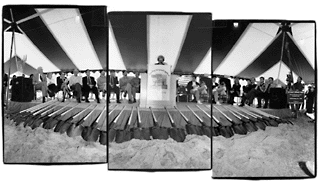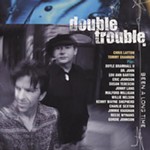A Big Tent
Two Largest Jewish Congregations Join Dell Campus
By Andy Langer, Fri., Dec. 19, 1997
|
|
"Groundbreaking" generally has two meanings: it's a specifier for a new or unique situation, and it's a symbolic shoveling of soil marking the beginning of an architectural project. A year ago this month, Austin's Jewish community believed they were witnessing both. On December 8, 1996, after a day of face-painting, bungee-jumping, and sandcastle building, local computer magnate Michael Dell, his wife Susan, and a dozen or so other VIPs grabbed shovels and broke ground at 7300 Hart Lane -- the future home of the much-anticipated Dell Jewish Community Campus. To date, that work represents the bulk of the JCC's construction. Even so, the proposed campus has indeed been moving ahead with its original goal intact: the construction of a facility to unite and galvanize the Jewish cultural community in Austin. As such, it is believed to be not only an ambitious and virtually unprecedented Jewish community center model for the nation, but also a homespun vehicle intended to keep up with what local community leaders estimate has been a five-year doubling of Austin's Jewish population, now at over 8,000 people.
But since the groundbreaking, everything has changed. Austin's two largest Jewish congregations -- the conservative Agudas Achim and the reformed Congregation Beth Israel -- voted last summer to accept the Jewish Federation of Austin's offer for the synagogue and temple to relocate their sanctuaries, religious school, and general operations to the campus site. Although an offer to join the campus plan had actually been extended as early as September of 1992 -- when the Dells originally purchased a 40-acre Northwest Hills lot and dedicated the bulk of the land to the building of a new home for Jewish Family Service and the Jewish Federation of Austin (JFA) -- Beth Israel's acceptance only came last May. Agudas Achim followed suit in August.
As a result, the Dell Community Campus has, with the addition of the Sylvia and Philip Spertus Jewish Community Center to the plan, now become a three-tiered project. The Dells' original directive is the same -- that the JFA would ultimately oversee the fundraising and completion of a five-year plan to build a campus with a multi-purpose community hall, senior adult center, early childhood program wing, fitness center, gymnasium, 25-meter swimming pool, nature trail, and a complex of outdoor sports fields. And although the JFA requested a zoning change and submitted permit applications to the city in September of 1996, before the groundbreaking, the news of the new three-tiered plan left the JFA's architects and construction experts requesting additional time. With the new plans now turned back in for consideration, only last week the Planning Commission postponed a vote on the JFA's proposal, reportedly so it and the city council could consider the protests of the Northwest Hills Neighborhood Association -- a group near the campus who apparently have traffic, noise, and parking concerns.
Representatives of the JFA and the two congregations say they'll know a lot more about the campus' construction after the commission's January meeting, although some experts within the local Jewish community say they've been told not to expect a completion date any time sooner than late 1999. But city and zoning questions aside, the campus' biggest long-term issue appears to be cultural. Can three separate entities, bound at this point only by denomination, exist together on the same campus? It's what some within the Jewish community are calling an "identity" or "governance" issue.
"Redesigning the whole site plan has been one thing, but it's just as important that we've made headway calibrating a point of view," says JFA President Sandy Dochen of the partnership committees working on building issues and programming. "Until the campus came along, these have been friendly relationships, not working relationships. So the inherent challenge has been setting up an infrastructure capable of working together on a campus that's much more than just three buildings juxtaposed."
But even before those buildings can be erected, representatives of each entity are out fundraising within the community to finance their individual moving and construction costs -- a project some say has been complicated by the fact that the JFA had a head start in locking in pledges, and that so many JFA contributors are also affiliated with one of the two congregations. On the other hand, representatives of both Agudas and Beth Israel say that because they each own their current buildings, they can finance the bulk of their relocation expenses through the future sales of those properties and through existing building/renovation funds. In fact, in Beth Israel's case, President David Goldstein says they ultimately considered moving to the campus a financial plus.
"In the past seven years, our congregation has doubled in size from 400 to 800 families. We're just out of space, and our decision to do something about that growth was coming upon us pretty rapidly," he says. "We saw three alternatives: staying where we are and expanding, finding another site, or going to the Dell Campus. After doing the financial research and looking at the whole campus concept, the congregation decided this was our most viable option."
Because of Beth Israel's growth, Goldstein says, space for its religious school and educational programming have been in short supply. Similarly, Agudas Achim President Alan Sager says his congregation found the move to the campus feasible in part because of the JFA's commitment to help the temple and synagogue raise funds for their religious school and after-school programs. Ironically, some are guessing that the Hebrew school and educational programs -- likely places for doctrinal differences to crop up -- will actually be the first area where all three entities combine efforts. Dochen's belief that some "joint programming" for the schools may be an eventuality orginally worried some community insiders, but Sagar says that some of the concern over identity issues seems to be winding down.
"Whether we can all keep our own identities has been one of the concerns all along," says Sager. "Some of us were more willing to take a leap of faith. I believe the competitive aspects will wash out, that we'll work together and keep our identities.... Just 20 years ago a franchiser wouldn't have been happy if a Baskin & Robbins and Dunkin' Donuts moved into the same store front. They'd have said they're in the same business. But now we know that selection like that keeps the people going there. Some days they eat donuts, other days ice cream. Everybody wins, and this shouldn't be much different."
Already, the theory is that the first winners, or beneficiaries, of the Dell Campus will be its organizers' children -- a group that not only stands to gain from the fundraising for the Hebrew schools, but also from their own politics-free community opportunities. "Growing up in Austin, like I did, most of the Jews lived in central Austin or Northwest Hills," says Goldstein. "All the families, and all the kids, used to know each other. Now, because Austin's Jewish population has become so geographically diverse, my kids don't know the kids from the other congregation and vice versa. This would bring them together, even if they're praying as separate entities. Right now, it's harder to reach out like that in three different facilities."
Already, according to the JFA, more Jews actually live in the campus' 78731 zip code than anywhere else in Austin. And because only
30-40% of the local Jewish community is affiliated with either of the two congregations, some say that once the campus' plans are approved and work begins, more Austin Jews will likely emerge and fall into what the JFA considers its practicing community. In fact, some local experts, including the Northwest Hills Neighborhood Association, have asked if the current 40-acre site might not in fact be too small to accommodate that community's growth. At this point, that question can't be answered. But as the campus' organizers prepare for a legitimate groundbreaking early next year, the JFA's Dochen is conceding there may be a need for some additional marketing -- aimed at the affiliated, unaffiliated, and even the campus' non-Jewish neighbors.
"We believe that, from the beginning, this has represented a wonderful opportunity," Dochen says. "For the Jewish community, this campus will offer a center for their activities and a way for new Austinites to come by the JFA and check out the two congregations because they're on the site, or vice versa. With that kind of cross-fertilization, we'll all grow together. Meanwhile, our vision has always also included the non-Jewish folks who are interested in joining the center, participating, and using the facilities. Some of our future neighbors know that, some don't. But this is an institution that doesn't exist in that form in Austin. We have a JCC [Jewish Community Center], but it plainly doesn't have the big marketing campaign to initiate people to the opportunities and the notion of a JCC itself, particularly in the neighborhood. Hopefully, we'll be able to get the word out that this won't just be good for Austin's Jews, but also Austin itself."
Got something to say on the subject? Send a letter to the editor.









